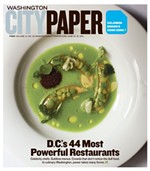Oh Bondage, I'm Yours!
It all started, really, with a rather innocent suggestion: “You know, I could take this little old bathing-suit top off if you like.” At least that’s how it goes in The Notorious Bettie Page, a film that will no doubt teach a few one-handed typers what real breasts look like. The iconic ’50s pinup is played by Gretchen Mol, and the movie falls solely on her frequently naked shoulders—and boobs and ass and the “something” that sometimes peeks out but that Page is always asked to hide due to obscenity laws.
With all the skin and objectification, it’s notable that the film was created by women. Director Mary Harron and co-writer Guinevere Turner—the pair last collaborated on 2000’s American Psycho, another project one might assume would be taken on by men—don’t exactly turn Page’s happenstance path from impromptu beach model to professional bondage queen into a feminist fairy tale, as some have suggested. The focus is on the God-fearing Page’s good-natured attitude regarding her career, with all the naughtiness pushed to the perimeter. When a photographer asks her what she believes Jesus would think of what she’s doing, Page replies, “God gave me this talent to pose for pictures, and they seem to make people happy”—therefore it can’t be wrong.
That defense, by the way, comes right after an S&M ball is removed from Page’s mouth, a scene that illustrates what Mol has called “this kind of non-judgmental spirit. People were always able to look at Bettie Page and see what they needed her to be.” The filmmakers, in fact, are counting on that. The Nashville-born model’s relationships, from the implied-abusive one she had with her father to the definitely abusive one she had with her first husband, Billy Neal (37-year-old Norman Reedus, fooling no one as a pomaded youngster), are summed up in no more than a few scenes. Ditto her victimization in a gang rape. Harron and Turner instead frame the story with the 1955 trial of siblings Irving and Paula Klaw (Chris Bauer and Lili Taylor), the money-grubbing fetish-porn producers responsible for turning Page from a fun-in-the-sun cutie into a corseted, high-heeled dominatrix/submissive in both photos and short movies. (The Klaws were charged not only for distributing obscenity via U.S. mail but also for contributing to a boy’s death because he’d purportedly emulated activities portrayed in their works—crimes pronounced more dangerous to the country than Communism.)
Mostly though, we get Bettie, Bettie, Bettie—and Mol, affecting an aw-shucks Southern accent and with those post–Vanity Fair days in the wilderness behind her, is more than ready for her close-up. With a black, banged wig, altered eyebrows, and an impressive body, Mol should placate fanboys and -girls who cried that someone with more edge—Angelina Jolie, say, or Rose McGowan—should have gotten the part. There’s no question that Mol seems an out-of-nowhere choice, but the casting ended up being just right: The actress bears a physical resemblance to Page, sure, but more important, she has the model’s cutie-pie demeanor and cheery—even goofy—smiles down cold. In the film, even her “strict” S&M expressions smack of playfulness.
It’s this attitude of dress-up fun that seems to be what Harron and Turner want us to take away from their subject’s haphazard life. The filmmakers don’t bother delving into the whys of Page’s choices but simply follow her from pretty schoolgirl to foxy pinup to lovely born-again Christian—the last transformation cued by a contemplative walk along the shore. Filled with bouncy jazz and ’50s pop and often funny, The Notorious Bettie Page is essentially lighthearted entertainment. Sure, when Page’s boyfriend, Marvin (Jonathan Woodward), finally sees her fetishistic photos, he pronounces them “disgusting.” But when a panting autograph-seeker shows up to ask Page if she’s sickened by her fans—and therefore wants to punish him—it’s comical, not sinister.
What the movie lacks in depth, however, it makes up for with style. Shot mostly in black and white but splashed here and there with color, The Notorious Bettie Page captures grainy old New York as well as it evokes Technicolorized old Florida, where Page posed for model-turned-photographer Bunny Yeager (Sarah Paulson). There’s also a nice montage of bright magazine covers, with a little living Page posing on them Harry Potter–style.
As good-natured as its subject’s smiles, The Notorious Bettie Page isn’t exactly a film of substance. But if it makes people happy, Harron and Turner seem to be implying, who’s to say it’s wrong?

